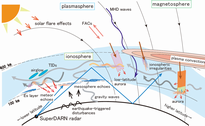** Progress in Earth and Planetary Science is the official journal of the Japan Geoscience Union, published in collaboration with its society members.
Gallery View of PEPS Articles
Review
Space and planetary sciences
Review of the accomplishments of Mid-latitude Super Dual Auroral Radar Network (SuperDARN) HF Radars
Nishitani N, Ruohoniemi JM, Lester M, Baker JBH, Koustov AV, Shepherd SG, Chisham G, Hori T, Thomas EG, Makarevich RA, Marchaudon A, Ponomarenko P, Wild JA, Milan SE, Bristow WA, Devlin J, Miller E, Greenwald RA, Ogawa T, Kikuchi T
Mid-latitude SuperDARN, Ionosphere, Magnetosphere, Convection, Ionospheric irregularities, HF propagation analysis, Ion-neutral interactions, MHD waves
Schematic plots showing the a Northern and b Southern Hemisphere SuperDARN radar locations with respect to the auroral oval. The model auroral oval (yellow) for moderately disturbed conditions is plotted with the SuperDARN radar locations identified in green type and green closed circles (polar cap latitudes), blue type and blue closed circles (auroral latitudes), and black type and red closed circles (mid-latitude radars).
Schematic illustration of natural phenomena which can be studied by SuperDARN radars.
The Super Dual Auroral Radar Network (SuperDARN) is a network of high-frequency (HF) radars located in the high- and mid-latitude regions of both hemispheres that is operated under international cooperation. The network was originally designed for monitoring the dynamics of the ionosphere and upper atmosphere in the high-latitude regions. However, over the last approximately 15 years, SuperDARN has expanded into the mid-latitude regions. With radar coverage that now extends continuously from auroral to sub-auroral and mid-latitudes, a wide variety of new scientific findings have been obtained. In this paper, the background of mid-latitude SuperDARN is presented at first. Then, the accomplishments made with mid-latitude SuperDARN radars are reviewed in five specified scientific and technical areas: convection, ionospheric irregularities, HF propagation analysis, ion-neutral interactions, and magnetohydrodynamic (MHD) waves. Finally, the present status of mid-latitude SuperDARN is updated and directions for future research are discussed.







